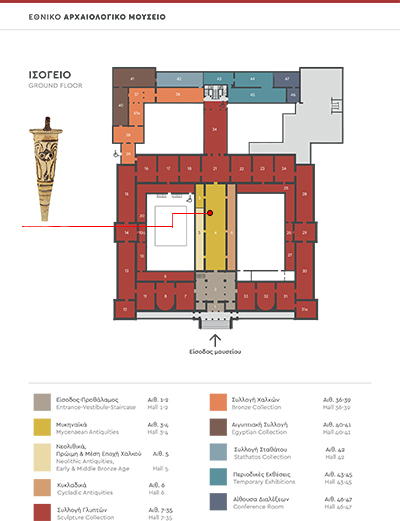Exhibit of the month
A rhyton with an octopus
Large conical rhyton with octopus decoration
Hellenic National Archaeological Museum, Collection of Prehistoric Antiquities, Inv.no. Π 7386
Provenance: Mycenae, “House of the Wine Mercant”
Dimensions: Height (with handle) 43.6 cm., diameter (rim) 15.1 cm.
Date: 1375 -1325 B.C. (Early LHIIIA2 period)
Display area: Room 4 (Mycenaean Gallery), Showcase 24
This large, conical rhyton is mended from fragments and restored at the base. Although it is one of the largest of its kind, neither its shape nor its decoration is unusual. This type of vessel most commonly had a conical shape in Mycenaean Greece in the 14th c. B.C., while the octopus has always been a constant source of artistic inspiration and creativity in the Aegean region. The movements of the tentacles in the water, which create impressive images, combined with the animal’s characteristics—which led Aristotle to describe it in detail[1]—impressed the Mycenaeans too. The artist of the rhyton depicts the octopus head-on, adapting it to the shape of the vase. However, the rendering of two of the tentacles is freer: one is depicted as a tuft on top of the head and the other below, giving the animal liveliness and grace. Four tentacles fill the wide band of the vase at the back, while two are rendered smaller, as if disappearing into the water.
Rhyta were perforated vessels in many different shapes, materials and decorations. They had two openings, typically positioned opposite each other, which allowed liquid to enter through one and exit through the other after a short time. This type of vessel was common in Minoan Crete, but also used during the Mycenaean period.[2] The frequent discovery of rhyta in sanctuaries and tombs, their depiction in religious scenes, and their resemblance to vessels from the Classical Period, lead us to conclude that they were undoubtedly associated with rituals involving libations or purification. However, as rhyta have also been found in other contexts, it has been suggested that they had also other uses, perhaps practical ones, such as functioning as funnels. While the shape of some rhyta lends itself to practical use, the practicality is undermined by their elaborate decoration.
This rhyton was discovered in 1952 alongside more than fifty stirrup jars and at least eight large pithoi in an impressive yet completely fire-damaged building. Based on these findings, the excavator, A. J. B. Wace, named the building ‘The House of the Wine Merchant’, although it is possible that the vessels may also have contained oil rather than wine. Despite its size and elaborate decoration, the rhyton is thought to have been used for filling the stirrup jars from the pithoi. However, the presence of a rhyton in a building that was probably used for craft production or storage does not preclude its use for ritual purposes. From Linear B tablets, we know that wine and oil were offerings used at banquets. Therefore, the large rhyton with the octopus could have been used in a ritual related to the production or storage of liquids for banquets.
[1] Aristotle describes the octopus (polypus) in several places throughout his multi-volume work “Historia Animalium”. Among other things, he describes the octopus as ‘stupid but thrifty’ (Book 9,37): “The octopus is a stupid creature, for it will approach a man’s hand if it be lowered in the water; but it is neat and thrifty in its habits..” (English translation by Sir D’Arcy Wentworth Thompson, 1910, Historia Animalium by Aristotle, Oxford: The Clarendon Press). Interestingly, Christos Tsountas wrote about octopus: “The sepia is a cunning animal. The ancients proverbially recognised the stupidity of the octopus” (Τσούντας, Χρ. Κυκλαδικά, ΑΕ 1898, 200).
[2] Possible recordings of rhyta are also found in Linear B tablets. At least two logograms from tablets from Knossos (*217VAS, *227VAS) as well as the word po-ro-ko-wo /prokhowos/ πρόχους found on a tablet from Mycenae probably refer to various types of rhyta.
Dr. Katerina Voutsa
Bibliography
Bendall, L.M. 2013. Does Linear B ideogram *211vas+PO indicate a rhyton?, Minos 39, 41-59.
Haskell, H.W. 1981. Coarse-ware Stirrup-jars at Mycenae. BSA 76, 225-238.
Koehl, R. B. 2006. Aegean Bronze Age Rhyta, Prehistory Monographs 19, Philadelphia: INSTAP Academic Press.
Wace, A.J.B. 1953. Mycenae. Preliminary Report on the Excavations in 1952, BSA 48, 16-17.
Wright, J. C. (ed.), 2004. The Mycenaean Feast, Hesperia 73.2, Princeton, New Jersey: The American School of Classical Studies at Athens.



